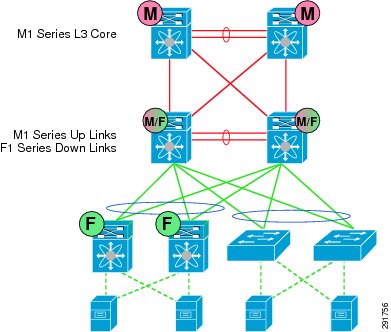Table Of Contents
Cisco Nexus 7000 F1 and M1 Modules in a
Virtualized Multi-Tenant Data Center ArchitectureCisco Nexus F1 I/O Module Integration into VMDC
Cisco Nexus 7000 F1 and M1 Modules in a
Virtualized Multi-Tenant Data Center Architecture
Overview
Cisco Virtualized Multi-Tenant Data Center (VMDC) is a validated reference architecture that delivers a highly-available, secure, flexible, and efficient data center infrastructure. VMDC provides the following benefits:
•
Reduced time to deployment
•
Reduced risk
•
Increased flexibility
•
Improved operational efficiency
Multi-tenancy enables business units, or compute environments that might have previously required separate security policies or entirely separate physical infrastructure to share physical resources, thereby reducing CAPEX and, the through resultant savings in power and footprint, OPEX.
The VMDC Tenant framework is modularized in a fashion that supports a single tenant deployment and is seamlessly expandable to a multi-tenant model without major reconfiguration or topology changes.
Benefits
The introduction of the Cisco Nexus® F1 I/O module enables the VMDC Reference Architecture to further optimize environmental considerations, such as floor space, power, and cooling, while enhancing scalability and paving the path for next generation technologies, such as FabricPath and FCoE. These technologies enable a unified fabric that supports cross-domain network and storage functions and provides higher availability and flexibility of the compute function.
Enterprises are faced with new challenges to support dynamic communication changing needs:
•
Meeting demands of new collaborative and communication environments
•
Improve resiliency and business responsiveness
•
Increasing bandwidth requirements
•
Reducing over all power, space, and cooling compliance and regulatory requirements
•
Business continuance
Cisco Nexus F1 I/O Module Integration into VMDC
The newly released F1 I/O Modules integrates seamlessly into the VMDC Reference Architecture and work in conjunction with M1 I/O modules from previous designs. The validated design below depicts a typical deployment of F1 and M1 Modules in a VMDC design. At the aggregation layer, F1 modules facing the access layer provide Layer 2 connectivity, while M1 modules connect northbound to the core layer for Layer 3 connectivity. A total of 40 Gbps of bandwidth from the access layer to the aggregation layer is available, making this ideally suited for your most demanding workloads. Best practices for the new F1 I/O module in combination with the M1 I/O module have been characterized in a VMDC environment.
Figure 1 VMDC Topology with F1 and M1 I/O Modules
•
Host level—Cisco Unified Computing System™ (UCS™) Virtualized or Bare Metal Servers
•
Access layer—Cisco Nexus 5000 pair with Peer-Link and vPC or Cisco Nexus 7000 with F1 Modules
•
Aggregation layer—Cisco Nexus 7000 with Mix of M1 and F1 Modules
Technical Specifics
Powered by the F1 Forwarding Engine Switch on Chip (SoC), the 32-port 1G/10G F1 module delivers 480 million packets per second (pps) of distributed Layer 2 forwarding and up to 320 Gbps of data throughput. A Cisco Nexus 7000 18-Slot switch fully populated with F1 I/O modules can deliver up to 10.2 Tbps of switching performance, with a typical power consumption of less than 10 watts (W) per port.
The F1 series delivers integrated hardware support for Fibre Channel over Ethernet (FCoE) and IEEE Data Center Bridging (DCB) protocols, as well as Cisco FabricPath, which enables the creation of scalable, flexible networks that efficiently use all available bandwidth between nodes. With the availability of software to support FCoE, the Nexus 7000 series switch with F1 I/O modules can be deployed in the server access layer to provide both LAN and storage connectivity via Converged Network Adapters (CNAs).
The M1 10G modules provide up to 80 Gbps of bandwidth to the switch fabric and up to 512 10G ports (4:1 oversubscribed) in a single 18-slot chassis, providing a high-density, compact solution for large 10Gb Ethernet networks.
Every M1 I/O module contains one or more integrated forwarding engines. This design scales the forwarding performance of the chassis linearly as a factor of the quantity of the I/O modules employed in the chassis. Each M1 forwarding engine delivers 60 million packets per second (Mpps) of Layer 2 and Layer 3 forwarding. The 8-port 10G I/O module carries two such engines, providing 120 Mpps. Thus, an 18-slot chassis with 16 8-port 10G M1 I/O modules processes nearly 2 billion packets per second. The fabric interface on M1 family modules delivers 80 Gbps of bandwidth in each direction, providing up to 2.5 Terabits per second (Tbps) system bandwidth in a Nexus 7018 chassis.
Table 1 Cisco Nexus 7000 Line Card Comparison
Layer 2 Table
128K
16K-256K
Layer 3 (IPv4, IPv6)
Yes
No
Netflow
Full
No
ACL
Up to 128K
1K-16K
SPAN/ERSPAN sessions
2 bidir
2 bidir (2 bidir + 12 unidir1 )
IEEE 1588/PTP
No
Yes1
Buffer per line-rate 10G port
176MB/port
2.3MB/port
Forwarding capacity per module
60-120Mpps
480Mpps
Line-rate 10G ports per module
8
20-322
Line rate 10G ports per chassis (10-slot/18-slot)
64/128
256/512
Latency (unicast local switching @ 64 bytes)
9.5 msec
4.7 msec
Power budget per line-rate 10G port
81W/port
12W/port
1 Hardware capability with future software support.
2 Dependent on frame size and amount of local switching.
For More Information
•
Cisco Nexus 7000 Series 32-Port 1 and 10 Gigabit Ethernet Module
http://www.cisco.com/en/US/prod/collateral/switches/ps9441/ps9402/data_sheet_c78-605622.html•
Cisco Nexus 7000 Series 32-Port 10Gb Ethernet Module, 80Gb Fabric
http://www.cisco.com/en/US/prod/collateral/switches/ps9441/ps9402/ps9512/Data_Sheet_C78-437757.html•
Virtualized Multi-Tenant Data Center New Technologies—VSG, Cisco Nexus 7000 F1 Line Cards, and Appliance-Based Services
http://www.cisco.com/en/US/docs/solutions/Enterprise/Data_Center/VMDC/2.6/vmdctechwp.html•
VMDC Design Zone
http://www.cisco.com/en/US/solutions/ns340/ns414/ns742/ns743/ns1050/landing_vmdc.html
